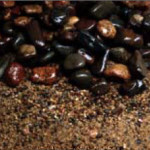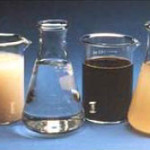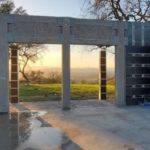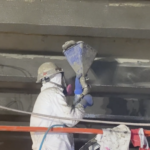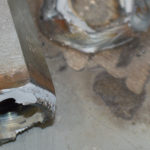Around Christmas, the Engineering Department does a white elephant gift exchange. We have no idea who framed this picture and wrapped it up the first time.
Several of our lab technicians (plus a product manager) are posing for the camera, and obviously trying to flex while sucking their bellies in during a concrete pour to test our SSTB(R) anchors. The tradition has it that if you end up with this picture, you hang it on your wall and re-gift it at next year’s gift exchange – so there it is, on the wall in Engineer Dustin’s office. The trick has become wrapping it so that nobody recognizes that it is the picture frame.
Speaking of concrete, between our test labs in Addison, Ill., Stockton and Pleasanton, Calif., we test a lot of concrete. We will certainly be doing a lot more testing to continue to support our new Repair, Protection and Strengthening Systems for Concrete and Masonry product line. But I will ask the lab technicians to keep their shirts on.
Concrete has been used as a construction material for centuries. Availability of locally sourced material and flexibility of its use makes concrete a popular material for construction. While concrete may not be considered high-tech, advances in concrete admixtures and placement techniques have come a long way since the Romans used the material to advance civilization. There are ASTM specifications established for concrete material properties, mixing, curing and protection. This week’s blog post will discuss some of the concrete specifications that may improve the quality of your next concrete project.
The basic ingredients of concrete include a cementitious material such as Portland cement, aggregates, water, and admixtures.
Portland Cement
ASTM C150 establishes the specification for Portland cement. The different types of cement range from Type I to Type V, the most common of which is Type I or general purpose. A summary of the common types of cement and their applications is available from Portland Cement Association (PCA). Supplementary cementitious materials such as fly ash and slag cement are commonly used in concrete. A newer approach to cement specification is available in ASTM C1157, Standard Specification for Hydraulic Cement. C1157 provides cement manufacturers wider latitude regarding composition of six types of cement and their performance requirements.
ASTM C33 provides the guideline for grading of concrete aggregates and ASTM C136 establishes the standard test method for sieve analysis of fine and course aggregates. There are grading limits to the size of aggregates since the surface area of a larger aggregate requires less paste (cement and water) than a smaller sized aggregate. The grading and aggregate size affects the workability, porosity, and pump-ability of concrete. Designers should be involved in the discussion of how the concrete will be placed in order to specify a mix that’s appropriate for the project.
Water
Water quality is a concern because even a small amount of chemicals can change the setting time and affect long-term performance of the concrete. ASTM C1602 provides specification for mixing water used in the production of concrete and details the requirements for testing water to ensure that it is suitable for use.
Any material deliberately added to concrete before or during mixing is called admixture. Admixtures are used to modify and improve specific properties of a concrete mixture. Common admixtures and their ASTM specification are listed below:
– ASTM C260 Air-entraining admixtures
– ASTM C494 Accelerating / retarding admixtures
– ASTM C1017 Water-reducing admixtures
Admixtures allow designers to tailor the concrete mix to suite the site conditions where concrete will be placed. In cold weather conditions, accelerating admixtures speed up setting time. In high temperature weather, retarding admixtures provides a longer working time before the concrete sets. Other special purpose admixtures include corrosion inhibitors, shrinkage reducers, and pumping aids. Additional information on uses of admixtures can be found at PCA.
Check out our new Repair, Protection and Strengthening Systems for Concrete and Masonry and sign up for the Simpson Strong-Tie Concrete News newsletter for articles on the latest industry news and code changes.
– Paul
What are your thoughts? Visit the blog and leave a comment!


